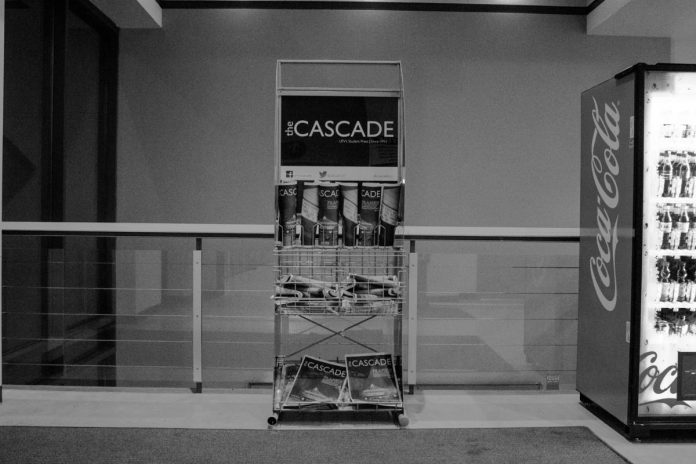CBC News recently reported that The Muse, the student newspaper at Memorial University (MUN) in St. John’s, Newfoundland, has had to suspend their print circulation for the duration of the fall semester. Although they’re located on the far side of the country, and have a longer history (and Wikipedia article) than The Cascade, they serve an only slightly larger student body, with a similarly sized team to what we have here in the Fraser Valley.
Now, don’t worry, The Cascade isn’t planning on going down the same route anytime soon. For one thing, while our $6.12 semester fee certainly doesn’t leave us with enough to be snacking on caviar during our meetings, it’s more than the $2.00 per semester MUN charges, which is also shared with their campus radio station. On top of that, The Muse’s distribution was 10,000 copies per issue, 10 times our 1,000 weekly copies.
Still, printing those papers is not an insignificant cost, and although we’ve managed to make it work, it is worth examining if The Muse’s strategy is worthwhile. The team here at The Cascade are all students too, and we pay these fees, and want to make sure they’re put to the best use possible. So, is it worth printing 1,000 paper copies every week?
I can see the argument against it. According to UFV’s 2016-2017 factbook, the average age for non-master’s degree graduates is mid-20s, and certainly, us millennials are fond of our online news. The Cascade could switch to online only, and hope to maintain the same sort of readership that we hold now, but I strongly think such an action would be a mistake.
For one thing, I’ve seen our numbers for online engagement, and the view count for our articles posted on ufvcascade.ca are all publicly visible, and are frequently only in the double or low triple digits. We know more people than that engage with what we’re writing, but, up to this point, the interest in our print content strongly outweighs that of our online presence, and it’s no secret that making the transition from one medium to another is rough — we can’t expect every person who picks up one of our papers from a newsstand while they wait for their bus to, upon seeing it absent, decide to go give us a like on Facebook, or a follow on Twitter. (Though if you want to, we’d be happy to have you!) There’s no shortage of online content, and being seen on social media is infinitely more difficult than being seen sitting on a table or in a rack on campus.
There are also benefits to a print medium that are less tangible than readership numbers. Universities are a place of learning, and our campus media is an extension of that. Classes are vital, yes, but hands-on experience within easy reach of students in invaluable. Finding opportunities like The Cascade or CIVL outside of campus is difficult and competitive, and may not be compatible with a class schedule. These organizations offer a chance for students like myself to practice our skills in an environment of collaborative learning — there are no UFV staff guiding or overseeing The Cascade — where we develop skills by doing real tasks for a real publication. And while shifting to an online format wouldn’t eliminate the role of our writers and editors, what about our production staff, who toil for hours every week to make this paper look as great as it does, or our business people who gain experience working with advertisers, printers, and a distribution system far more involved than simply hitting “publish” on a website? There’s also something to be said for the legitimacy of a physical newspaper. Even with all of the same requirements and standards, our team experience may not be taken as seriously if their experience was solely online — there’s absolutely a lingering perception that anyone can put their writing on the internet, so it has less value, less prestige, than something printed in ink.
Print media on the whole may be dying. That’s no longer news, as more and more newspapers across the country go out of business, or are consolidated into mega-corporations. But campus print media doesn’t have to take the same route. Because we aren’t wholly dependent on advertisers, and don’t have to resort to sponsored content, with continued smart business management we can continue to offer experience to the students who create this paper, report news, share insights, and (hopefully) some laughs too, with UFV and the surrounding community. It’s also part of our mandate to provide an alternative news source for the Fraser Valley, and the ability to provide our perspective in a format that isn’t beholden to the demands of advertisers is a critical part of the journalistic ecosystem. Print may be dying, but printing of The Cascade doesn’t have to. Our position as a student newspaper means that, as long as our fellow students choose to keep supporting us, we can maintain the same model we’ve had since 1993.

Jeff was The Cascade's Editor in Chief for the latter half of 2022, having previously served as Digital Media Manager, Culture & Events Editor, and Opinion Editor. One time he held all three of those positions for a month, and he's not sure how he survived that. He started at The Cascade in 2016.


